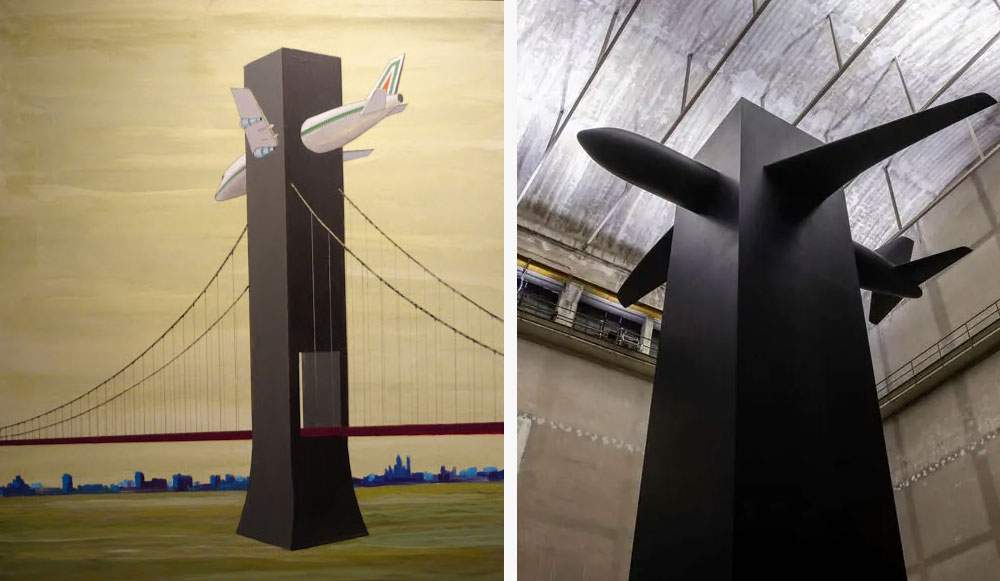Historical ebb and flow: Cattelan's plane and Ico Parisi's plane
Surely, visitors to Maurizio Cattelan ’s Breath Ghosts Blind exhibition (at Pirelli HangarBicocca in Milan from July 15, 2021 to February 20, 2022) who have also been to the Pinacoteca Civica in Como could not help but notice the strong resemblance of Blind, one of the three works the Paduan artist is exhibiting at his new solo show, to a 1985 acrylic painting by Ico Parisi (Domenico Parisi; Palermo, 1916 - Como, 1996), belonging to the series Architecture After: both artists in fact depicted an airliner trapped inside a tall parallelepiped (in Ico Parisi’s case it is the pylon of a bridge).
Cattelan’s work is seen as a reference to theSeptember 11 attacks (and moreover, many of those who see Ico Parisi’s canvas, inspired by the same suggestion, call it “prophetic”), and in the exhibition catalog the artist declares that it was “something I had in mind for years.” Architecture afterwards, on the other hand, is a series intended to explore the possibilities of architecture, even on a symbolic level (the work at the Pinacoteca di Como is not the only one in which the plane is inside another element: there is also another work in which the same Alitalia plane is seen inside a brick pyramid: a probable reference to architecture as a means of holding back a contemporary society that runs trpppo fast?), with bizarre, ironic and utopian proposals.
Domenico Parisi, known as Ico, born in Palermo in 1916 but moved with his family to Como since 1920, is one of the most interesting figures in 20th-century architecture. He came into contact with Giuseppe Terragni, trained in the theories of Carlo Belli and Alberto Sartoris, graduated in architecture in Lausanne in 1950, but before that, with his wife Luisa Aiani, whom he married in 1947, he founded Studio La Ruota in Como in 1948. His projects include Casa Carcano (Maslianico, 1949), in whose design he involved Mario Radice and Fausto Melotti, and then again Casa Notari (Fino Mornasco, 1949), the Sondrio Chamber of Commerce, Industry and Agriculture (1953), the Living Room Pavilion for the 10th Triennale (Milan, 1954), the Hotel Corte dei Butteri and the church of Santa Maria dell’Osa (Fonteblanda di Grosseto, 1962), Casa Orlandi (Erba, 1966), Casa Fontana (1968) and Casa Vivere Insieme (Montorfano, 1969). A friend of Gio Ponti, in contact with artists such as Lucio Fontana, Francesco Somaini and Fausto Melotti, he was inspired by the principles of the Synthesis of the Arts, and theorized the confrontation between artists and architects as the core of his creative method. In 1978 he also participated in the Venice Biennale, and in 1982 in DOcumenta in Kassel. Instead, his first anthological exhibition dates back to 1986, at the PAC in Milan(Ico Parisi: l’Officina del possibile). Today, the Pinacoteca Civica di Como preserves the Ico and Luisa Parisi fund, donated by the artist in 1995. The archive includes mainly transparencies (generally the technical drawings), sketches (the drafts) and photographs (the images of the work).
Cattelan is an educated artist who often quotes other colleagues in his works: and so here is the reinterpretation of the airplane forced into the block at the Pirelli HangarBicocca solo show. For those unfamiliar with the visionary (and, in some ways, somewhat forgotten) world of Ico Parisi, however, this could be an interesting opportunity to learn more.
Pictured: left, Ico Parisi, Architecture after (1985; acrylic on canvas; Como, Pinacoteca Civica). Right, Maurizio Cattelan, Blind (2021; resin), photo by Agostino Osio
 |
| Historical ebb and flow: Cattelan's plane and Ico Parisi's plane |
Warning: the translation into English of the original Italian article was created using automatic tools. We undertake to review all articles, but we do not guarantee the total absence of inaccuracies in the translation due to the program. You can find the original by clicking on the ITA button. If you find any mistake,please contact us.





























